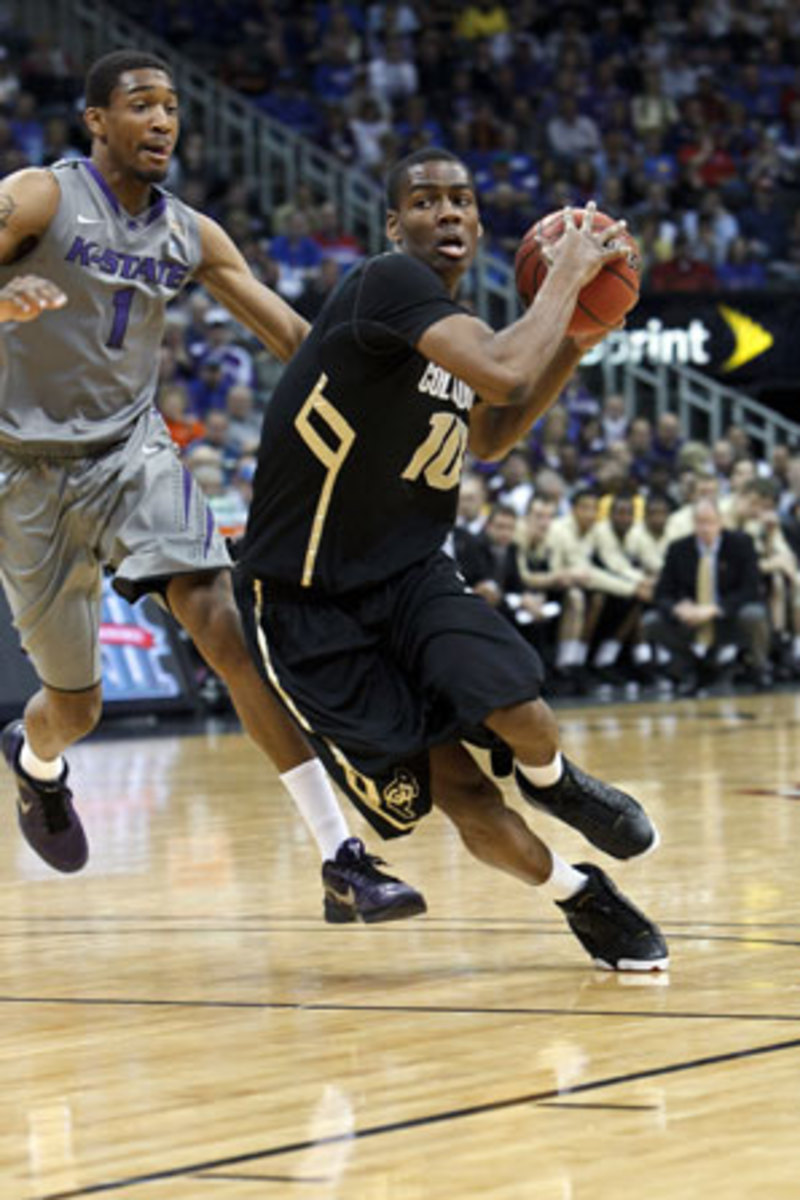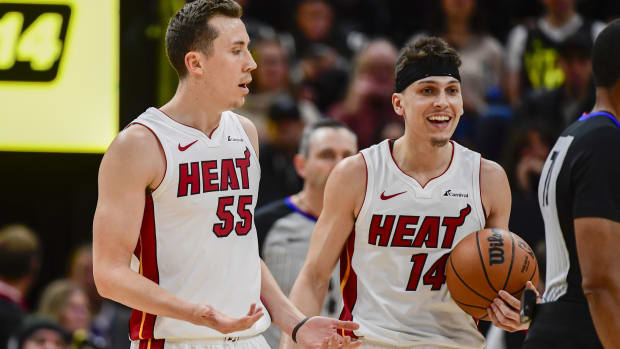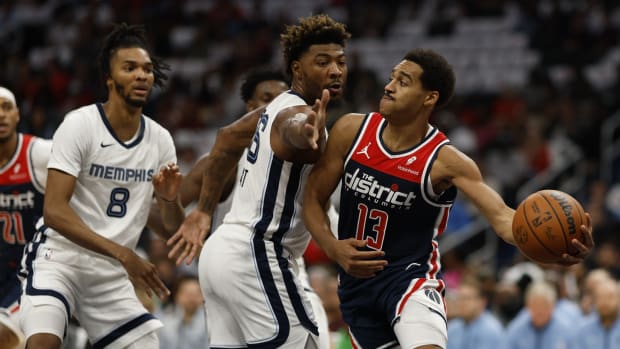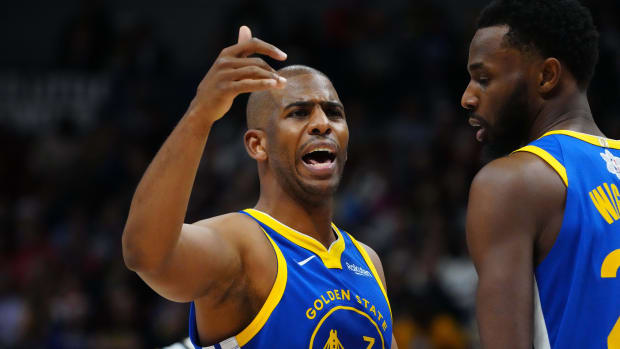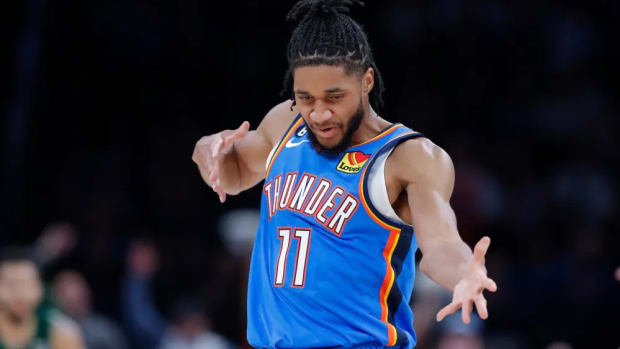GM's weak draft is inspiration for unheralded college recruits
The reputable Internet mock drafts suggest there are 40 names in realistic contention for 30 first-round contracts. Eight of those 40 are internationals who came from outside the U.S. grassroots system. Twenty-one are Americans who, by their final AAU summer, had a reasonable amount of hype surrounding their recruitment, with either four-star or better ratings on Rivals.com or Scout.com, or a spot in the sites' top 100 rankings.
The other 11, at the same juncture, were relatively anonymous, toiling on the outside of the AAU hype machine. Young players who derive their self-worth from recruiting rankings, or see them as the end-all assessment of talent (rather than what they are: an imperfect science practiced in good faith by the recruiting services), should take heed of that stat. Approximately a quarter of the names called in Thursday's first round will be players who were anonymous during the prime of their recruitments. The NBA draft does not discriminate against the late-bloomers or the under-appreciated.
Consider the case of Alec Burks, who left Colorado after two strong seasons and could be the first shooting guard off the board, somewhere in the 10-14 range. At the start of the summer of 2008, before his senior year of high school in Grandview, Mo., he had zero scholarship offers. He had just joined a fledgling AAU program, Spiece Mo-Kan Elite, that had yet to build a reputation on the grassroots scene. When Mo-Kan's chairman, Matt Suther, tried to tip off some mid-major coaches he knew about Burks, the response was tepid.
"There were some Missouri Valley [Conference] coaches I know -- and I won't name names, because I don't want them to get bad pub -- who saw Alec, and for whatever reason, never put an offer on the table," Suther said. "I still give them s*** all the time about that."
Kansas State showed interest in Burks after he attended a camp in Manhattan, and Suther also made a pitch to Colorado assistant Steve McClain. Still, it took Buffaloes coach Jeff Bzdelik stumbling upon Burks at a July camp outside Kansas City for his limited, major-conference recruitment to truly begin. "I was in a gym with no air conditioning, and just one other coach in the stands," Bzdelik said. "And I was there to see another player, a 6-foot-9 guy who didn't end up impressing me.
"But Alec was on the same court, and I remember him making a move right in front of me on the baseline, where he took a lazy dribble left, and then quickly did a Tim Hardaway crossover, drove baseline and dunked. That caught my eye. He made a few more moves like that; I started following him, and I've been following him ever since."
The other coach had daydreamed through Burks' brilliance, and Bzdelik managed to get Burks to commit to the Buffaloes in October, then sign early that November. He proceeded to have a monster senior year, winning a state title and being named the Gatorade Player of the Year in Missouri. "I went to see Alec [during that season] with an assistant, and we just looked at one another and said, 'We've got ourselves a gem,'" Bzdelik said.
One recruiting class earlier, Washington State and Providence found their own three-star gems at the shooting guard position. Despite being the son of the No. 1 pick in the 1978 NBA Draft (Mychal Thompson) and playing in the Los Angeles area (at Santa Margarita Catholic), Klay Thompson did not win over any of the local elites. Mychal said he "practically begged" USC coach Tim Floyd to recruit Klay, but Floyd wouldn't, and the only Pac-10 school that stepped up with an offer was Wazzu. Thompson, once a three-star recruit, is likely to become the highest-picked Cougar in the history of the NBA draft, potentially going ahead of Burks at No. 9 or 10.
Marshon Brooks, the other shooting guard with a shot at the Lottery, signed with Providence in April 2007, as a three-star prospect out of Tucker, Ga., whose only other offers were Kennesaw State and Jackson State. He grew from 6-3 to 6-5, filled out his frame, and by 2010-11 was the nation's second-leading scorer at 24.6 points per game.
The lone player ahead of Brooks on the NCAA's scoring leaderboard was BYU's Jimmer Fredette, who could be selected as high as No. 7 on Thursday. Fredette's college rock-stardom reached such a level that his first name dually functioned as a verb, and even casual fans knew his biographical quirks -- that he had scrimmaged against inmates in upstate New York jails, or that his brother was a Mormon rapper. Yet in the fall of 2006, during his senior year of high school, the three-star guard from Glens Falls, N.Y., did not have a single offer from a Big East team.
Siena was lone school in his region to extend a scholarship, and so Fredette took his talents to Provo, where he'd win the Wooden and Naismith Awards as a senior. Two of his signature performances came in Mountain West duels with San Diego State, whose star forward, Kawhi Leonard, had been similarly underhyped coming out of Riverside, Calif. He signed with the Aztecs in the fall of his senior year, after being ignored by the entire Pac-10. "He is going to show them," one of Leonard's Riverside King teammates said in an Los Angeles Times article the following March, and Leonard did show them: After an All-America sophomore season, he's a leading candidate (along with Fredette) to be taken with Sacramento's lottery pick.
Only one Pac-10 player, Arizona's Derrick Williams, is projected to come off the board before Leonard. Williams was underappreciated in his own right, having played at an obscure high school in La Mirada, Calif., and served as a role player on a Team Odom AAU squad whose featured scorer was Texas-bound Jordan Hamilton. Williams was released from a letter of intent at USC after Tim Floyd's resignation, and was the lowest-rated player in the Wildcats' five-man 2009 recruiting class. Articles (including one I wrote) about new Arizona coach Sean Miller's late recruiting haul focused mostly on his quartet of four-star guys: Kyryl Natyazhko, Solomon Hill, Kevin Parrom and LaMont "MoMo" Jones. The first three are still playing in Tucson, while Jones has since transferred to Iona. Williams, the lone three-star recruit, is about to be one of the first two picks in the draft.
Picks in the bottom third of the first round, meanwhile, could include a player who detoured through the junior-college ranks (Marquette forward Jimmy Butler), one who redshirted his freshman season (Hofstra combo guard Charles Jenkins), one who didn't start in high school until his senior season (Richmond forward Justin Harper), and two who were ignored by their hometown programs and forced to make their name in the Horizon League (Butler guard Shelvin Mack, from Lexington, Ky., and Cleveland State guard Norris Cole, from Dayton, Ohio).
No one in guaranteed-contract territory, however, comes from a smaller conference than Morehead State power forward Kenneth Faried, who will go down as one of the biggest recruiting misses of all time. In an age when it's difficult for New York-area prospects not to be overhyped, Faried toiled in obscurity at Newark (N.J.) Technology High, putting up crooked rebounding numbers but scaring off some colleges due to shaky academics and lack of a clear position (he was just 6-6, rail-thin, and lacking offensive polish).
Faried had no star rating on Rivals.com, and only Marist and Morehead State pursued him aggressively. He took just one official visit, to Morehead, before committing to the Eagles in February 2007. Four seasons later, with Faried on the verge of breaking Tim Duncan's NCAA record for career rebounds, Morehead coach Donnie Tyndall would sit in his office and say, "I thought [Faried] would be a guy who could start for us for three years and make all-conference before he graduated. Now, I call him a once-in-a-lifetime player at this school. Even if I'm fortunate enough to coach at Morehead for 20 years, I'll probably only have one Kenneth Faried."
As a senior, Faried didn't just break Duncan's record: He led the nation in offensive and defensive rebounding percentage, and helped the Eagles pull off a seismic upset of Louisville in the first round of the NCAA tournament. On Thursday night, he'll be at Newark's Prudential Center, just a few miles from where he grew up in the gritty Zion Towers projects, and he'll be walking on a stage to shake the hand of NBA commissioner David Stern.
The meaning of that moment should not be lost on long-shot prospects who tune in on TV. Four years ago, Kenneth Faried -- much like Burks or Williams -- was no one, and now he's on the verge of the NBA. A GM's weak draft can be a no-star recruit's inspiration, if that recruit chooses to defy his ranking rather than let it define him. The hype may miss you in high school, and at the outset of college, but you can still make it to the league. Right there, on 2011's first-round board, is precedent after precedent.






























